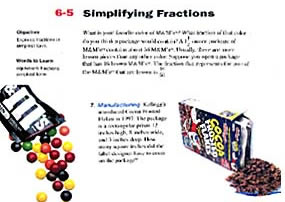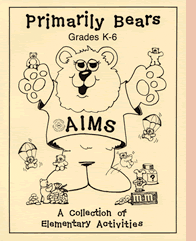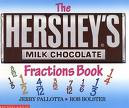
One aim of corporate produced classroom materials is to familiarise students with their brands and products. James McNeal, an expert in marketing to children, advises those wanting to get brand loyalty amongst children to firstly create awareness by taking advantage of the child’s curiosity and eagerness to learn: “Therefore, frequent presentations of the firm’s logo, slogans, and brand names within the child’s environment will produce awareness of a firm.”
 In April 2014, parents complained that brand names, including Nike, Barbie, iPod, Mug Root Beer, LEGO, IBM and Life Savers, were included in school standardised tests for over a million children from grades 3 to 8 in New York.
In April 2014, parents complained that brand names, including Nike, Barbie, iPod, Mug Root Beer, LEGO, IBM and Life Savers, were included in school standardised tests for over a million children from grades 3 to 8 in New York.
The Nike question was about being a risk taker and included the line, "'Just Do It' is a registered trademark of Nike," according to students who took the test.
The tests were written by the education arm of Pearson, which claimed that the product placements were not paid for. They are the first not to be made public after they are used. However many if not all these brands have commercial ties to Pearson (see for example LEGO, Nike, Apple).

 In the 1990s some of the corporate sponsored educational materials were less sophisticated. Software for teaching children to read required them to read sentences such as “I like eating at McDonald’s” or “I like drinking Pepsi”.
In the 1990s some of the corporate sponsored educational materials were less sophisticated. Software for teaching children to read required them to read sentences such as “I like eating at McDonald’s” or “I like drinking Pepsi”.

One kit put out by Teacher Support Software, which was used in many kindergartens in Texas, included test questions such as “Taco Bell has [blank] and burritos.”

McGraw-Hill’s textbook Mathematics: Applications and Connections, published in second edition in 1999, used brand names, “glossy photos of products and corporate logos, and exercises that send students off to their favourite stores at the shopping mall” to teach them about how mathematics applies in the real world. “They learn symmetry by studying the design of Chevrolet and Hallmark logos. They learn to plot data by creating graphs charting Nike and Reebok sales”. They work out problems like how long it would take to be able to buy a pair of Nike shoes, given a particular weekly allowance. They are asked to express the diameter of an Oreo cookie as a fraction” but as part of the background information for the exercise are told that “The best-selling packaged cookie in the world is the Oreo cookie”. The book was used by schools in 15 states in the US and was originally offered free in California.
logos, and exercises that send students off to their favourite stores at the shopping mall” to teach them about how mathematics applies in the real world. “They learn symmetry by studying the design of Chevrolet and Hallmark logos. They learn to plot data by creating graphs charting Nike and Reebok sales”. They work out problems like how long it would take to be able to buy a pair of Nike shoes, given a particular weekly allowance. They are asked to express the diameter of an Oreo cookie as a fraction” but as part of the background information for the exercise are told that “The best-selling packaged cookie in the world is the Oreo cookie”. The book was used by schools in 15 states in the US and was originally offered free in California.
Today the commercial message is likely to be more subtle, sometimes so subtle that the teachers don’t even notice it. If they do they may turn a blind eye so that they can use the materials, which are hard for teachers to resist, particularly those from poorly resourced schools.
The materials, professionally produced with lots of colour and games, prepared homework assignments and even computers that automatically grade the students work, are generally offered for free.

McGraw Hill’s website has included maths lessons that featured Crayola and Hershey products: “One exercise has students selecting items from Hershey’s online catalogue and then calculating the shipping charges and taxes.”

McGraw Hill continues to include branded products in its lessons. Breakthrough to Literacy, a McGraw-Hill company, produces Take-Me-Home books as a classroom resource. Its current website suggests one activity might be to “place marshmallows or M&M’s on words matching those read by the teacher”.

 AIMS Education Foundation is a non-profit group in the US that produces mathematics and science materials for schools featuring brand names. Packets of M&Ms are used to practice sorting and graphing and counting as well as statistical analysis, as are Gummy Bears. In By Golly, By Gum, By Time students “discover how the mass of gum is affected by the amount of time it is chewed”.
AIMS Education Foundation is a non-profit group in the US that produces mathematics and science materials for schools featuring brand names. Packets of M&Ms are used to practice sorting and graphing and counting as well as statistical analysis, as are Gummy Bears. In By Golly, By Gum, By Time students “discover how the mass of gum is affected by the amount of time it is chewed”.

 Reese’s Pieces: Count by Fives; Hershey’s Milk Chocolate Bar Fractions Book; Skittles Math Riddles; and The Cheerios Play Book, of which 1.2 million copies had been sold by the end of 2000, all teach young children to do maths using branded products.
Reese’s Pieces: Count by Fives; Hershey’s Milk Chocolate Bar Fractions Book; Skittles Math Riddles; and The Cheerios Play Book, of which 1.2 million copies had been sold by the end of 2000, all teach young children to do maths using branded products.

Nabisco’s math curriculum asks children to estimate the number of chocolate chips in a bag of its Chips-A-Hoy.
English textbooks used around the world also contain product placements. For example, Pearson Longman's Total English Intermediate contains pages on Adidas and Puma with a reading comprehension text, several exercises and a picture of Adidas trainers as well as pictures of international brands scattered throughout the book, including Nike, BMW, Samsung, Chanel, Esso, Versace.
Oxford University Press publishes New Headway English texts which include reference to Lonely Planet, Starbucks coffee, Apple Macintosh as well as The Body Shop and Walt Disney (pdf of Disney pages).
Similarly, Cambridge University Press's English test face2face contains the following exercises based on passages about KFC and McDonalds:

Campbell’s early lesson plan posters, distributed to 12,000 teachers, showed children how to do science with an experiment to show how its spaghetti sauce is thicker than its competitor’s.

A science course put together by Pepsi and others, was titled The Carbonated Beverage Company, and involved the students doing taste tests on cola drinks, analysing them and taking a video tour of a Pepsi factory as well as actually visiting one.

In 1998 a literacy kit, Brand Knew, was launched in Perth, Australia. It purported to teach reading and word skills to children from four years old with games and stories incorporating brand names and corporate logos. The rationale was that children recognised brand names before most other words and the aim was to sell a place in the kit to corporations for $10,000 each, in return for “brand recognition and awareness”.

A similar rationale was used in an instructional reading software program for the same age group entitled “Read-A-Logo” which was used by schools in Texas.

 KFC and Hasbro jointly produced classroom materials on "How the Body Works" including posters and teachers guide with an estimated reach of 1 million studnets in 2,760 schools. "The client’s objective was to promote KFC’s November launch of their new and improved KFC Laptop Meals and to enhance brand affinity by using the game of 'Operation' by Hasbro.
KFC and Hasbro jointly produced classroom materials on "How the Body Works" including posters and teachers guide with an estimated reach of 1 million studnets in 2,760 schools. "The client’s objective was to promote KFC’s November launch of their new and improved KFC Laptop Meals and to enhance brand affinity by using the game of 'Operation' by Hasbro.

Procter and Gamble produces an educational package entitled Always Changing: About You: Puberty and Stuff that includes a video and reading materials that advise students about using antiperspirant, and product samples such as an Old Spice stick for boys.

 Between 1999 and 2003 Nike's "Air to Earth Program" classroom kit reached more than 650,000 US students with a project that purported to show how Nike reused shoes returned to them to make play surfaces. (It can be downloaded here.) As part of the project student teams made a tennis shoe. The Center for Commerical-Free Education found that Nike reatilers knew nothing about Nike recycling shoes and called the kit "a typical example of advertising thinly disguised to masquerade as educational materials".
Between 1999 and 2003 Nike's "Air to Earth Program" classroom kit reached more than 650,000 US students with a project that purported to show how Nike reused shoes returned to them to make play surfaces. (It can be downloaded here.) As part of the project student teams made a tennis shoe. The Center for Commerical-Free Education found that Nike reatilers knew nothing about Nike recycling shoes and called the kit "a typical example of advertising thinly disguised to masquerade as educational materials".

Nike sent teachers sneaker-making kits that were supposed to teach children about environmentally responsible manufacturing.

Revlon’s school materials teach children about “good and bad hair days”.

 Disney’s Comics in the Classroom uses comics to teach 3rd grade children to read and write.
Disney’s Comics in the Classroom uses comics to teach 3rd grade children to read and write.

The Walt Disney Company sent 240,000 educational guides to schools on its film The Lion, the Witch, and the Wardrobe and the original book by C.S. Lewis on which it was based.

The makers of Clearasil distribute an ‘educational’ package on skin care complete with product samples and a brochure directing students to a website with games and sweepstakes.

In France, children have been taught how to brush their teeth with materials supplied by Colgate and older children have been taught about the European single currency from the Leclerc supermarket chain.

A French textbook published by Hachette for ten year old school students featured Nestle, JVC, Swatch and Air Inter.

In recent years movie distributors have been paying the Australian Teachers of Media to produce study guides based on their latest releases as a way of promoting them. The guides are included in study packs with a free movie pass and emailed to 26,000 teachers, bypassing the education departments and boards of study. They are also available on the internet.
If you have any examples or updates you would like to contribute please email them to me and I will add them here. Please give references for where you sourced the information.